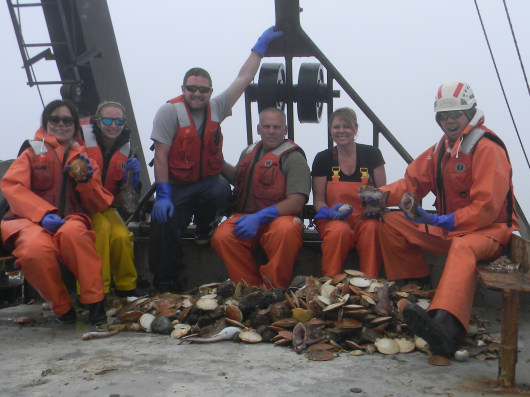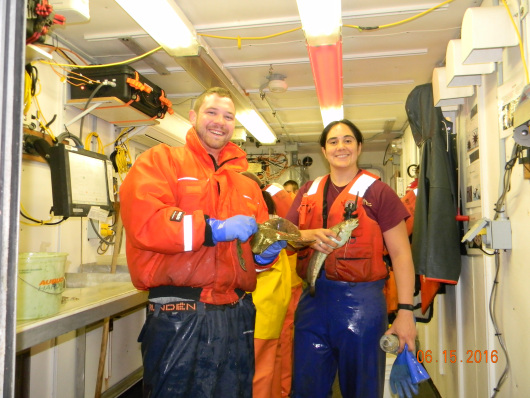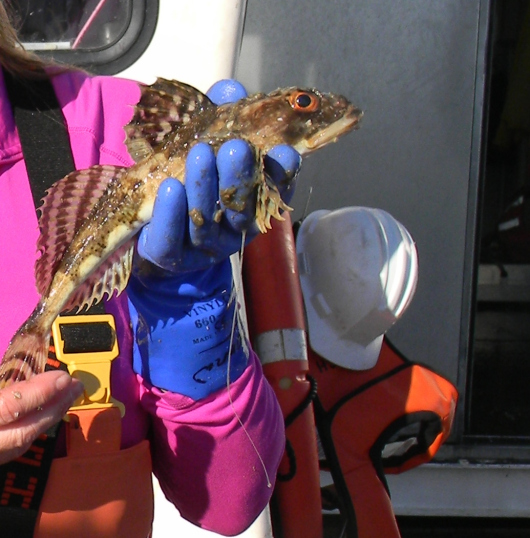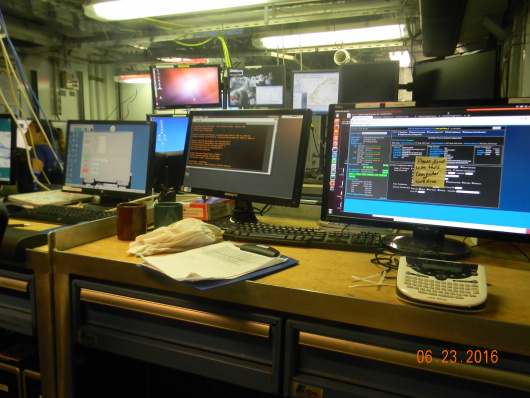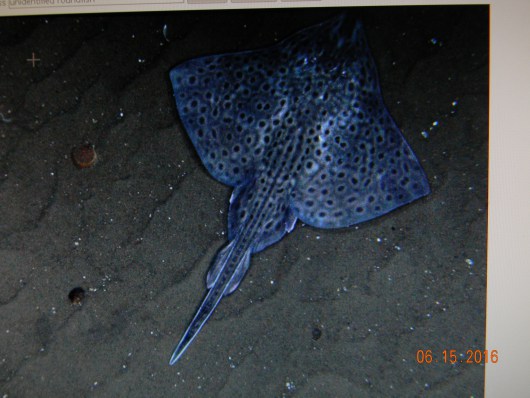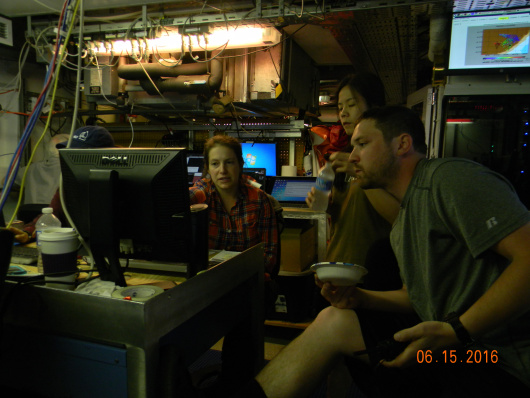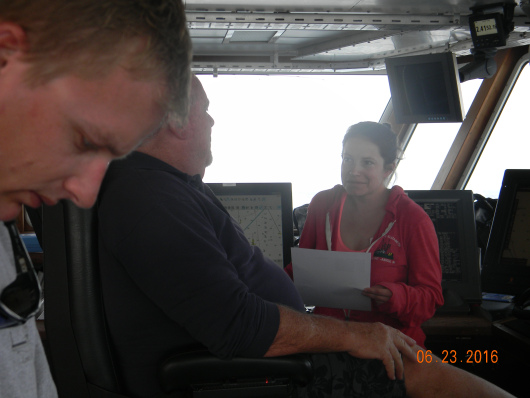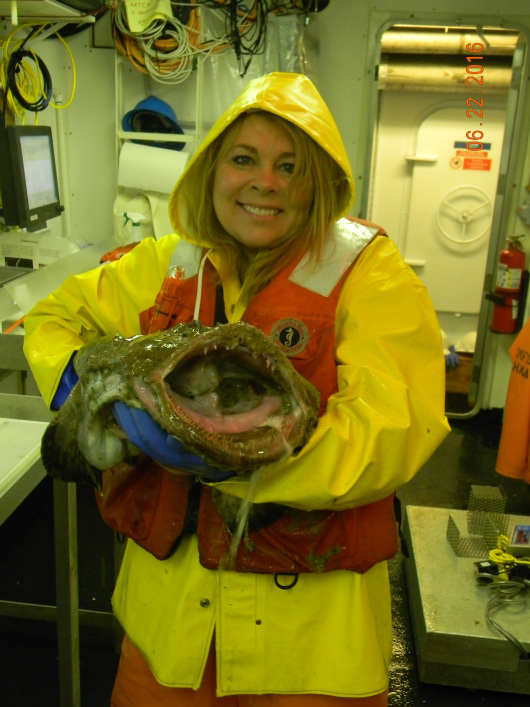NOAA Teacher at Sea
Trevor Hance
Aboard R/V Hugh R. Sharp
June 12 – 24, 2015
Mission: Sea Scallop Survey
Geographical area: New England/Georges Bank
Date: June 21, 2015

Teacher at Sea?
Science and Technology Log
The rhythm of a ship rocking and rolling through varied wave heights while catching some zzzz’s in a small, curtain-enclosed bunk provides an opportunity to get some really amazing deep sleep. Last night I had a dream that one of my childhood friends married Dan Marino. It seemed completely bizarre until I remembered we saw lots of dolphins yesterday.

Dan? Mrs. Marino? Is that you?
Seas have calmed substantially from the ride we had a couple of days ago, and for the past few days the ride has been so smooth I feel more like a “Teacher at Pond” than “Teacher at Sea.” Unfortunately, it looks like that awful weather system my friends and family have been dealing back home in Texas is about to make its way to us here off the coast of New England (what many Texans consider “the southern edge of Santa-land”) and there’s even a chance today might be our last full day at sea.

At the helm: Estoy El Jefe!
Operations
Operationally, we’ve shifted back and forth from dredge to HabCam work and it is a decidedly different experience, and as with everything, there are pros and cons.
HabCam
As mentioned in an earlier blog, the HabCam requires two people to monitor two different stations as pilot and co-pilot, each with several monitors to help keep the system running smoothly and providing updates on things like salinity, depth and water temperature (currently 4.59 degrees Celsius – yikes!!!).

Views of the screens we monitor: from 6 o’clock, moving clockwise: the winch, altitude monitor, cameras of back deck, sonar of the sea floor and photos being taken as we travel
The pilot gets to drive the HabCam with a joystick that pays-out or pulls in the tow-wire, trying to keep the HabCam “flying” about 2 meters off the sea floor. Changes in topography, currents, and motion of the vessel all contribute to the challenge. The co-pilot primarily monitors and annotates the photographs that are continually taken and fed into one of the computers in our dry-lab. I’ll share more about annotating in the next blog-post, but essentially, you have to review, categorize and sort photos based on the information each contains.

The winch has its own monitor
Driving the HabCam gives you a feeling of adventure – I find myself imagining I am driving The Nautilus and Curiosity, but, after about an hour, things get bleary, and it’s time to switch and let one of the other crew members take over. My rule is to tap-out when I start feeling a little too much like Steve Zissou.
Dredge
Dredge work involves dropping a weighted ring bag that is lined with net-like material to the sea floor and towing it behind the vessel, where it acts as a sieve and filters out the smallest things and catches the larger things, which are sorted, weighed and measured in the wet lab on the back deck.

Close up of the dredge material; HabCam in the background
Dredge work is a little like the “waves-crashing-across-the-deck” stuff that you see on overly dramatized TV shows like “Deadliest Catch.” As my students know, I like getting my hands dirty, so I tend to very much enjoy the wind, water and salty experience associated with a dredge.

Yours truly, after a successful dredge, sporting my homemade Jolly Roger t-shirt
While the dredge is fun, my students and I use motion-triggered wildlife cameras to study the life and systems in the Preserve behind our school, and I fully realize the value those cameras provide — especially in helping us understand when we have too much human traffic in the Preserve. The non-invasive aspects of HabCam work provide a similar window, and a remarkable, reliable data source when you consider that the data pertaining to one particular photograph could potentially be reviewed thousands of times for various purposes. The sheer quantity of data we collect on a HabCam run is overwhelming in real-time, and there are thousands of photos that need to be annotated (i.e. – reviewed and organized) after each cruise.
More Science
Anyway, enough of the operational stuff we are doing on this trip for now, let’s talk about some science behind this trip… I’m going to present this section as though I’m having a conversation with a student (student’s voice italicized).

Life needs death; this is a shot of 8 or 9 different crabs feasting on a dead skate that settled at the bottom. Ain’t no party like a dead skate party…
Mr. Hance, can’t we look at pictures instead of having class? I mean, even your Mom commented on your blog and said this marine science seems a little thick.
We’ll look at pictures in a minute, but before we do, I need you to realize what you already know.
The National Wildlife Federation gives folks a chance to support biodiversity by developing a “Certified Wildlife Habitat” right in their own backyard. We used NWF’s plan in our class as a guideline as we learned that the mammals, amphibians, reptiles and birds we study in our Preserve need four basic things for survival: water, food, shelter and space (note: while not clearly stated in NWF’s guidelines, “air” is built in.)
This same guide is largely true for marine life, and because we are starting small and building the story, we should probably look at some physics and geology to see some of the tools we are working with to draw a parallel.
Ugh, more water and rocks? I want to see DOLPHINS, Mr. Hance!
Sorry, kid, but we’re doing water and rocks before more dolphins.
Keep in mind the flow of currents around Georges Bank and the important role they play in distributing water and transporting things, big and small. Remember what happened to Nemo when he was hanging out with Crush? You’ll see why that sort of stuff loosely plays in to today’s lesson.

Let There Be Light! And Heat!
As I mentioned in an earlier post, Georges Bank is a shallow shoal, which means the sea floor has a lot more access to sunlight than the deeper areas around it, which is important for two big reasons. First, students will recall that “light travels in a straight line until it strikes an object, at which point it….” (yada, yada, yada). In this case, the water refracts as it hits the water (“passes through a medium”) and where the water is really shallow, the sunlight can actually reflect off of the sea floor (as was apparent in that NASA photo I posted in my last blog.)
Also important is the role the sun plays as the massive energy driver behind pretty much everything on earth. So, just like in our edible garden back at school, the sun provides energy (heat and light), which we know are necessary for plant growth.
Okay, so we have energy, Mr. Hance, but what do fish do for homes?
The substrate, or the sediment(s) that make-up the sea floor on Georges Bank consists of material favorable for marine habitat and shelter. The shallowest areas of Georges Bank are made mostly of sand or shell hash (“bits and pieces”) that can be moved around by currents, often forming sand waves. Sand waves are sort of the underwater equivalent of what we consider sand dunes on the beach. In addition to the largely sandy areas, the northern areas of the Bank include lots of gravel left behind as glaciers retreated (i.e. – when Georges Bank was still land.)
Moving currents and the size of the sediment on the sea floor are important factors in scallop population, and they play a particularly significant role relating to larval transportation and settlement. Revisiting our understanding of Newton’s three laws of motion, you’ll recognize that the finer sediment (i.e. – small and light) are easily moved by currents in areas of high energy (i.e. – frequent or strong currents), while larger sediment like large grains of sand, gravel and boulders get increasingly tough to push around.
Importantly, not all of Georges Bank is a “high energy” area, and the more stable areas provide a better opportunity for both flora and fauna habitat. In perhaps simpler terms, the harder, more immobile substrates provide solid surfaces as well as “nooks and crannies” for plants to attach and grow, as well as a place for larvae (such as very young scallop) to attach or hide from predators until they are large enough to start swimming, perhaps in search of food or a better habitat.
With something to hold on to, you might even see what scientists call “biogenic” habitat, or places where the plants and animals themselves make up the shelter.

Substrate samples from one of our dredges; shells, sand, rocks/gravel/pebbles, “bio-trash” and a very young crab

There is one strand of a plant growing off of this rock we pulled up. Not much, but it’s something to hold on to!
Hmmmmmmmmmmmmm, rocks and one weed, huh… I wonder what’s happening at the pool…
Whoa, hold on, don’t quit — you’re half way there!
Before you mind drifts off thinking that there are coral reefs or something similar here, it is probably important that I remind you that the sea floor of Georges Bank doesn’t include a whole lot of rapid topography changes – remember, we are towing a very expensive, 3500 lb. steel framed camera at about 6 knots, and it wouldn’t make sense to do that in an area where we might smash it into a bunch of reefs or boulders. Here, things are pretty flat and relatively smooth, sand waves and the occasional boulder being the exceptions.
Okay, our scallops now have a place to start their life, but, what about breathing and eating, and why do they need “space” to survive? Isn’t the ocean huge?
As always, remember that we are trying to find a balance, or equilibrium in the system we are studying.
One example of a simple system can be found in the aquaponics systems we built in our classroom last year. Aquaponics is soil-less gardening, where fish live in a tank below a grow bed and the water they “pollute” through natural bodily functions (aka – “poop”) is circulated to the grow bed where the plants get the nutrients they need, filter out the waste and return good, healthy water back to the fish, full of the micronutrients the fish need to survive. I say our system is simple because we are “simply” trying to balance ammonia, nitrates and phosphates and not the vast number of variables that exist in the oceans that cover most of our Earth’s surface. Although the ocean is much larger on the spatial scale, the concept isn’t really that much different, the physical properties of matter are what they are, and waste needs to be processed in order for a healthy system to stay balanced.

Our simple classroom system
Another aspect of our aquaponics system that provides a parallel to Georges Bank lies in our “current,” which for us is the pump-driven movement of water from the fish to the plants, and the natural, gravity-driven return of that water to the fish. While the transportation of nutrients necessary to both parties is directionally the exact opposite of what happens here on Georges Bank (i.e. – the currents push the nutrients up from the depths here), the idea is the same and again, it is moving water that supports life.
But, Mr. Hance, where do those “nutrients” come from in the first place, and what are they feeding?
Remember, systems run in repetitive cycles; ideally, they are completely predictable. In a very basic sense where plants and animals are concerned, that repetitive cycle is “life to death to life to death, etc…” This is another one of those “here, look at what you already know” moments.
When marine life dies, that carbon-based organic material sinks towards the bottom of the ocean and continues to break down while being pushed around at depth along the oceans currents. Students will recognize a parallel in “The Audit” Legacy Project from this spring when they think about what is happening in those three compost bins in our edible garden; our turning that compost pile is pretty much what is happening to all of those important nutrients getting rolled around in the moving water out here – microscopic plants and animals are using those as building blocks for their life.

Our new compost system
Oh wait, so, this is all about the relationship between decomposers, producers and consumers? But, Mr. Hance, I thought that was just in the garden?
Yes, “nutrient rich” water is the equivalent of “good soil,” but, we have to get it to a depth appropriate for marine life to really start to flourish. Using your knowledge of the properties of matter, you figured out how and why the currents behave the way they do here. You now know that when those currents reach Georges Bank, they are pushed to the surface and during the warm summer months, they get trapped in this shallow(ish), warm(ish) sunlit water, providing a wonderful opportunity for the oceans’ primary producers, phytoplankton, to use those nutrients much like we see in our garden.
Ohhhhhhhhhhhh, I think I’m starting to see what you mean. Can you tell me a little more about plankton?
The term plankton encompasses all of the lowest members of the food chain (web), and can be further divided into “phytoplankton” and “zooplankton.” Yes, “phyto” does indeed resemble “photo,” as in “photosynthesis”, and does indeed relate to microscopic plant-like plankton, like algae. Zooplankton pertains to microscopic animal-like plankton, and can include copepods and krill.
Plankton are tiny and although they might try to swim against the current, they aren’t really strong enough, so they get carried along, providing valuable nutrients to bigger sea creatures they encounter. Just like on land, there are good growing seasons and bad growing seasons for these phytoplankton, and on Georges Bank, the better times for growing coincide with the spring-summer currents.
Dude, Mr. Hance, I didn’t know I already knew that…. Mind…. Blown.
Yeah little dude, I saw the whole thing. First, you were like, whoa! And then you were like, WHOA! And then you were like, whoa… Sorry, I got carried away; another Nemo flashback. While I get back in teacher-mode, why don’t you build the food web. Next stop, knowledge…

You’ve got some serious thrill issues, dude
But, Mr. Hance, you are on a scallop survey. How do they fit into the food web? You told us that you, crabs and starfish are their primary natural predators, but, what are they eating, and how?
Scallops are animals, complete with muscles (well, one big, strong one), a digestive system, reproductive system, and nervous system. They don’t really have a brain (like ours), but, they do have light-sensing eyes on their mantle, which is a ring that sits on the outer edge of their organ system housed under their protective shell. Acting in concert, those eyes help scallops sense nearby danger, including predators like those creepy starfish.

Predators
Scallops are filter feeders who live off of plankton, and they process lots of water. With their shells open, water moves over a filtering structure, which you can imagine as a sort of sieve made of mucus that traps food. Hair-like cilia transport the food to the scallop’s mouth, where it is digested, processed, and the waste excreted.

The text is small, but, it describes some of the anatomy of the scallop. Click to zoom.

But, Mr. Hance, do they hunt? How do they find their food?
Remember, scallops, unlike most other bivalves such as oysters, are free-living, mobile animals; in other words, they can swim to dinner if necessary. Of course, they’d prefer to just be lazy and hang out in lounge chairs while the food is brought to them (kind of like the big-bellied humans in my favorite Disney film, Wall-E), so can you guess what they look for?
Gee, Mr. Hance…. Let me guess, water that moves the food to them?
Yep, see, I told you this was stuff you already knew.

I highlighted the shadows in one of the HabCam photos to show you proof that scallop swim.
While plankton can (and do!) live everywhere in the shallow(ish) ocean, because they are helpless against the force of the current, they get trapped in downwellings, which is a unique “vertical eddy,” caused by competing currents, or “fronts.” Think of a downwelling as sort of the opposite of a tug-o-war where instead of pulling apart, the two currents run head-on into one another. Eventually, something’s gotta give, and gravity is there to lend a hand, pushing the water down towards the sea floor and away, where it joins another current and continues on.
Those of you who have fished offshore will recognize these spots as a “slick” on the top of the water, and there is often a lot of sea-foam (“bubbles”) associated with a downwelling because of the accumulation of protein and “trash” that gets stuck on top as the water drops off underneath it.

Those “smooth as glass” spots are where currents are hitting and downwellings are occurring

This particularly large group of birds gathered together atop a downwelling, likely because the water helped keep them together (and because fishing would be good there!)
Because plankton aren’t strong enough to swim against the current, they move into these downwellings in great numbers. You can wind up with an underwater cloud of plankton in those instances, and it doesn’t take long for fish and whales to figure out that nature is setting the table for them. Like our human friends in Wall-E, scallops pull up a chair, put on their bibs and settle at the base of these competing fronts, salivating like a Pavlovian pup as they wait on their venti-sized planko-latte (okay, I’m exaggerating; scallops live in salt water, so they don’t salivate, but because I’m not there to sing and dance to hold your attention while you read, I have to keep you interested somehow.)
If you become a marine scientist at Woods Hole, you’ll probably spend some time looking for the “magic” 60m isobaths, which is where you see scallop and other things congregate at these convergent fronts.
Before you ask, an isobaths is a depth line. Depth lines are important when you consider appropriate marine life habitat, just like altitude would be when you ask why there aren’t more trees when you get off the ski lift at the top of the mountain.
Um, Mr. Hance, why didn’t you just tell us this is just like the garden! I’m immediately bored. What else ya got?
Well, in the next class, we’ll spend some time talking about (over-)fishing and fisheries management, but for now, how about I introduce you to another one of my new friends and then show you some pictures?
I don’t know, Mr. Hance, all of this talk about water makes me want to go swimming. I’ll stick around for a few minutes, but this dude better be cool.
Lagniappe: Dr. Burton Shank
Today, I’ll introduce another important member of the science crew aboard the vessel, Dr. Burton Shank. As I was preparing for the voyage, I received several introductory emails, and I regret that I didn’t respond to the one I received from Burton asking for more information. He’s a box of knowledge.

That’s Burton, on the right, sorting through a dredge with lots and lots of sand dollars.
Burton is a Research Fishery Biologist at National Marine Fisheries Service in Woods Hole working in the populations dynamic group, which involves lots of statistical analysis (aka – Mental Abuse To Humans, or “MATH”). Burton’s group looks at data to determine how many scallops or lobsters are in the area, and how well they are doing using the data collected through these field surveys. One of my students last year did a pretty similar study last year, dissecting owl pellets and setting (humane) rat traps to determine how many Great Horned Owls our Preserve could support. Good stuff.
Burton is an Aggie (Whoop! Gig ‘Em!), having received his undergraduate degree from Texas A&M at Galveston before receiving his master’s in oceanography from the University of Puerto Rico and heading off as a travelling technical specialist on gigs in Florida, Alaska and at the Biosphere in Arizona. For those unfamiliar, the biosphere was a project intended to help start human colonies on other planets, and after a couple of unsuccessful starts, the research portion was taken over by Columbia University and Burton was hired to do ocean climate manipulations. Unlike most science experiments where you try to maintain balance, Burton’s job was to design ways that might “wreck” the system to determine potential climate situations that could occur in different environments.
As seems to be the case with several of the folks out here, Burton didn’t really grow up in a coastal, marine environment, and in fact, his childhood years were spent in quite the opposite environment: Nebraska, where his dad was involved in agricultural research. He did, however, have a small river and oxbow like near his home and spent some summers in Hawaii.
It was on during a summer visit to Hawaii at about 9 years old that Burton realized that “life in a mask and fins” was the life for him. On return to Nebraska, home of the (then!) mighty Cornhusker football team, many of his fellow fourth grade students proclaimed that they would be the quarterback at Nebraska when they grew up. Burton said his teacher seemed to think being the Cornhusker QB was a completely reasonable career path, but audibly scoffed when he was asked what he wanted to be and said he would be a marine biologist when he grew up. I welcome any of you young Burton’s in my class, anytime – “12th Man” or not!
Photoblog:

Sheerwater, I loved the reflection on this one

Such a nice day

You’ll never look at them the same, will you?

Cleaning up after a dredge; shot from vestibule where wet-gear is housed. We spent lots of time changing.

So fun to see lobsters and crabs when “HabCam’ing.” They rear back and raise their claws as if to dare you to get any closer.

Good night!
Playlist: Matisyahu, Seu Jorge, Gotan Project, George Jones
Okay, that’s it, class dismissed. Get outta here…
Mr. Hance

